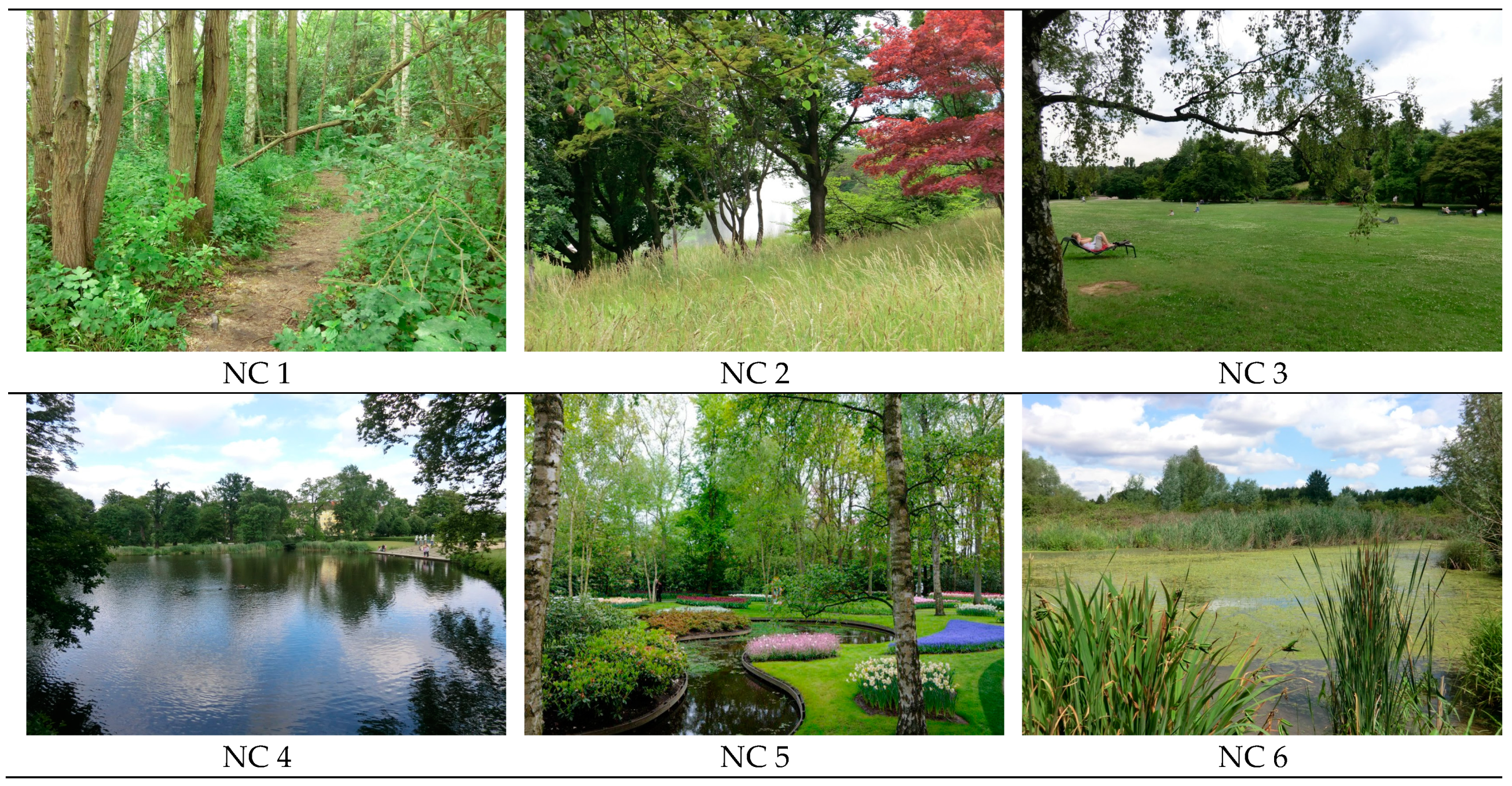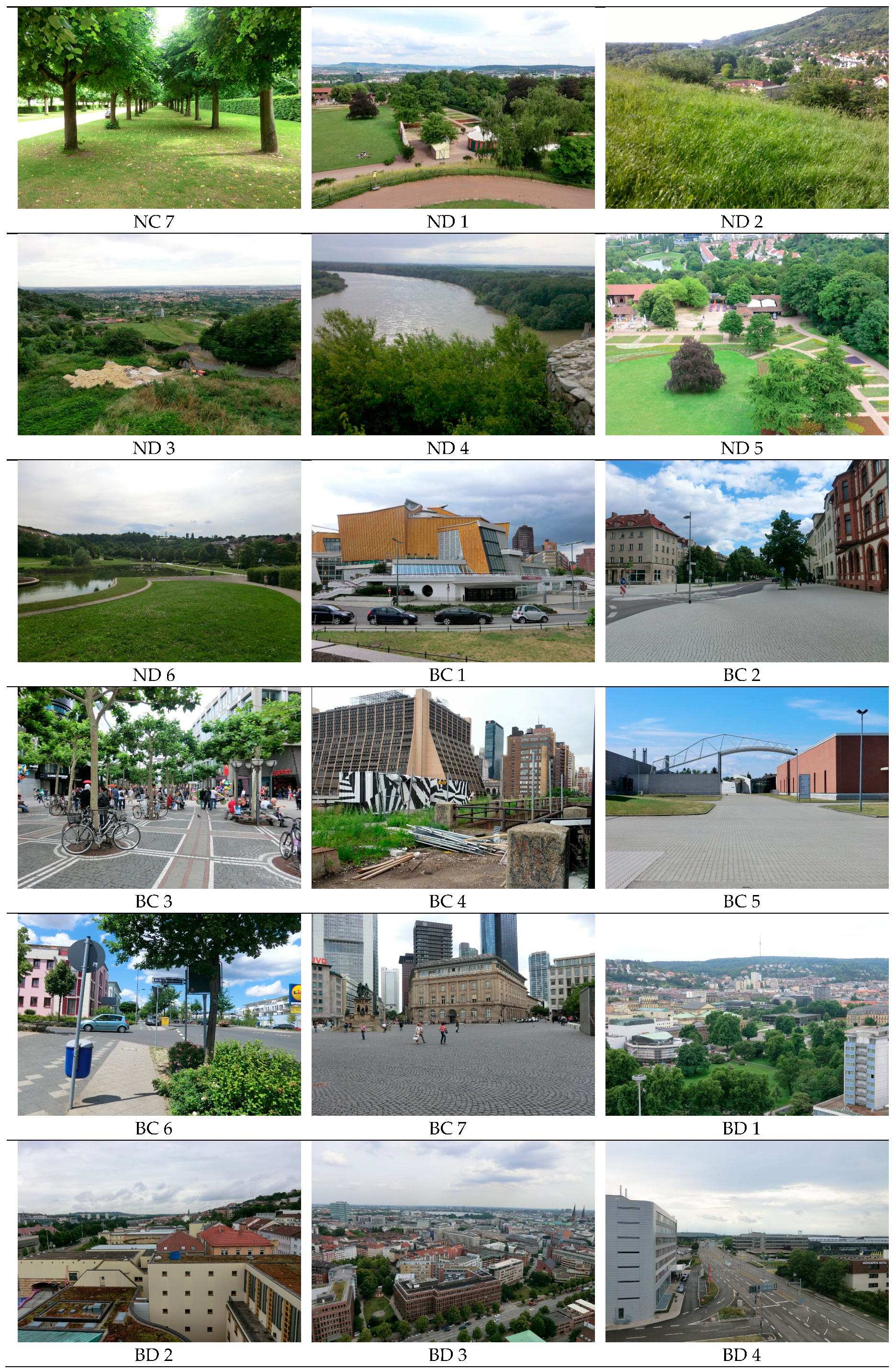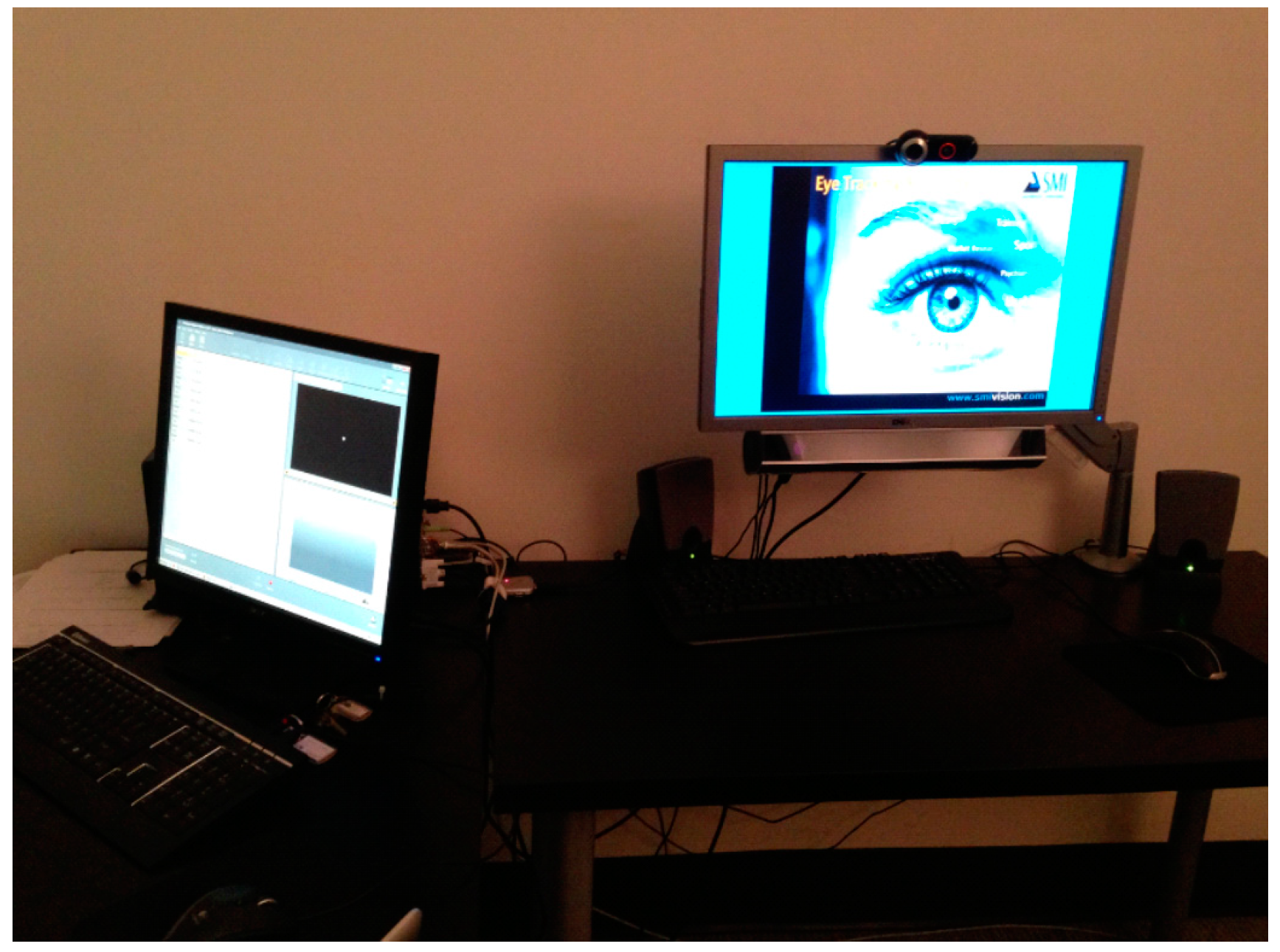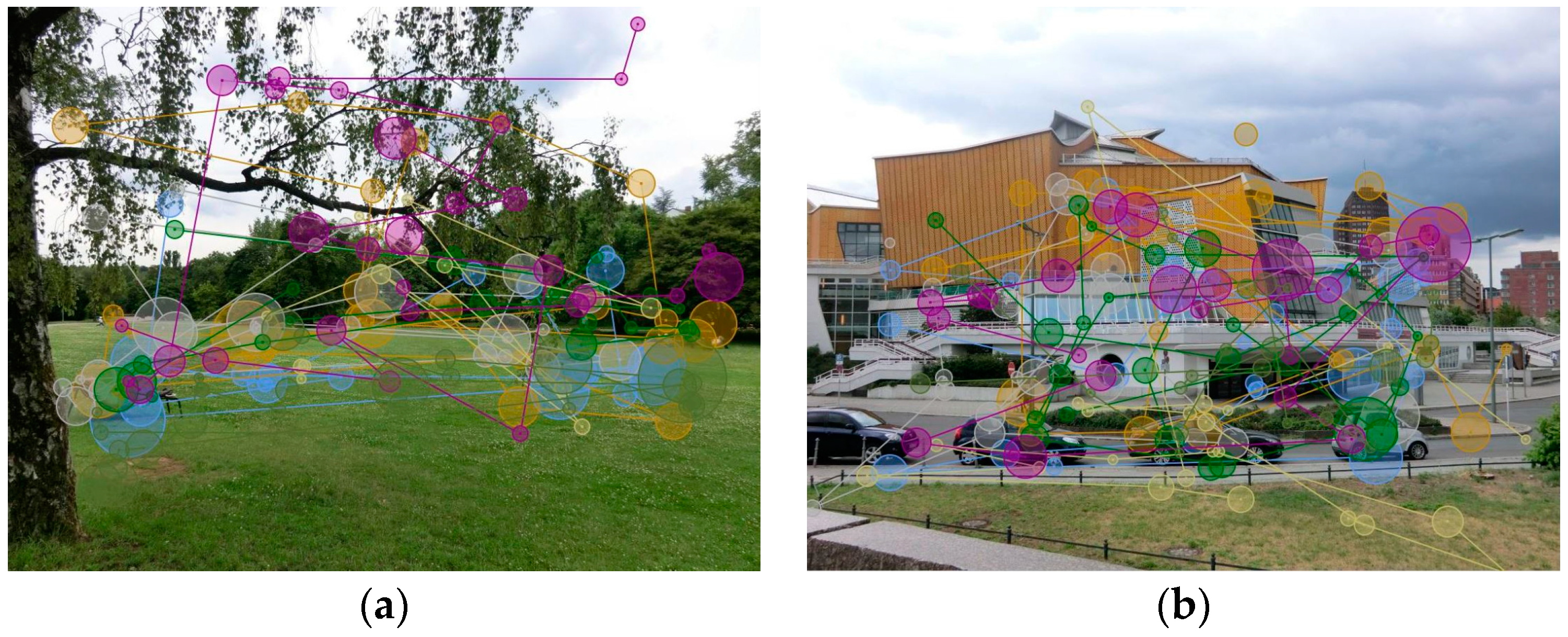Differences of Restorative Effects While Viewing Urban Landscapes and Green Landscapes
Abstract
1. Introduction
1.1. Attention Restoration Theory
1.2. Restorative Effect and the Natural Environment
1.3. Visual Characteristics Mediating Restorative Effects
1.4. Eye Tracking as a Tool for Evaluating Environmental Perception
1.5. Research Hypotheses
2. Methods
2.1. Research Process
2.2. Study Design
2.3. Eye-Tracking Apparatus
2.4. Participants
2.5. Measurement
- That is a place which is away from everyday demands and where I would be able to relax and think about what interests me (being away);
- That place is fascinating; it is large enough for me to discover and be curious about things (fascination);
- That is a place where the activities and items are ordered and organized (coherence);
- That is a place which is very large, with no restrictions to movements; it is a world of its own (scope);
- In that place, it is easy to orient and move around so that I could do what I like (compatibility).
3. Results
3.1. Visual Characteristics of Landscapes with High Scores
3.2. Results Regarding Restorative Landscapes
3.3. Eye-Movement Analysis and Visualization
4. Discussion
4.1. Implications of Restorative Landscapes
4.2. Methodological Considerations (Eye-Tracking Methods)
5. Conclusions
Author Contributions
Funding
Conflicts of Interest
Appendix A



References
- Arnberger, A.; Eder, R. Are urban visitors’ general preferences for green-spaces similar to their preferences when seeking stress relief? Urban For. Urban Green. 2015, 14, 872–882. [Google Scholar] [CrossRef]
- Galea, S.; Udding, M.; Koenen, K. The urban environment and mental disorders. Epigenetics 2011, 6, 400–404. [Google Scholar] [CrossRef]
- Grahn, P.; Stigsdotter, U.A. Landscape planning and stress. Urban For. Urban Green. 2003, 2, 1–18. [Google Scholar] [CrossRef]
- Hartig, T.; Staats, H. The need for psychological restoration as a determinant of environmental preferences. J. Environ. Psychol. 2006, 26, 215–226. [Google Scholar] [CrossRef]
- Lee, K.E.; Williams, K.J.H.; Sargent, L.D.; Williams, N.S.G.; Johnson, K.A. 40-s Green roof views sustain attention: The role of micro-breaks in attention restoration. J. Environ. Psychol. 2015, 42, 182–189. [Google Scholar] [CrossRef]
- van den Berg, M.; Wendel-vos, W.; van Poppel, M.; Kemper, H.; van Mechelen, W.; Maas, J. Health benefits of green spaces in the living environment: A systematic review of epidemiological studies. Urban For. Urban Green. 2015, 14, 806–816. [Google Scholar] [CrossRef]
- Srivastava, K. Urbanization and mental health. Ind. Psychiatry J. 2009, 18, 75–76. [Google Scholar] [CrossRef]
- Staats, H.; Kieviet, A.; Hartig, T. Where to recover from attentional fatigue: An expectancy-value analysis of environmental preference. J. Environ. Psychol. 2003, 23, 147–157. [Google Scholar] [CrossRef]
- Vujcic, M.; Tomicevic-dubljevic, J.; Grbic, M.; Lecic-tosevski, D. Nature based solution for improving mental health and well-being in urban areas. Environ. Res. 2017, 158, 385–392. [Google Scholar] [CrossRef]
- Nordh, H.; Alalouch, C.; Hartig, T. Assessing restorative components of small urban parks using conjoint methodology. Urban For. Urban Green. 2011, 10, 95–103. [Google Scholar] [CrossRef]
- Jiang, S. Therapeutic landscapes and healing gardens: A review of Chinese literature in relation to the studies in western countries. Front. Archit. Res. 2014, 3, 141–153. [Google Scholar] [CrossRef]
- Tyrväinen, L.; Ojala, A.; Korpela, K.; Lanki, T.; Tsunetsugu, Y.; Kagawa, T. The influence of urban green environments on stress relief measures: A field experiment. J. Environ. Psychol. 2014, 38, 1–9. [Google Scholar] [CrossRef]
- Cottet, M.; Vaudor, L.; Tronchere, H.; Roux-Michollet, D.; Augendre, M.; Brault, V. Using gaze behavior to gain insights into the impacts of naturalness on city dwellers’ perceptions and valuation of a landscape. J. Environ. Psychol. 2018, 60, 9–20. [Google Scholar] [CrossRef]
- Schafer, R.M. The Soundscape: Our Sonic Environment and the Tuning of the World; Destiny Books: Rochester, NY, USA, 1977. [Google Scholar]
- Carles, J.; Barrio, I.; de Lucio, J. Sound influence on landscape values. Landsc. Urban Plan. 1999, 43, 191–200. [Google Scholar] [CrossRef]
- Hong, X.; Liu, J.; Wang, G.; Jiang, Y.; Wu, S.; Lan, S. Factors influencing the harmonious degree of soundscape in urban forests: A comparison of broad-leaved and coniferous forests. Urban For. Urban Green. 2019, 39, 18–25. [Google Scholar] [CrossRef]
- Jeon, J.Y.; Hong, J.Y. Classification of urban park soundscapes through perceptions of the acoustical environments. Landsc. Urban Plan. 2015, 141, 100–111. [Google Scholar] [CrossRef]
- Ren, X.; Kang, J.; Zhu, P.; Wang, S. Effects of soundscape on rural landscape evaluations. Environ. Impact Assess. Rev. 2018, 70, 45–56. [Google Scholar] [CrossRef]
- Kaplan, S. The restorative benefits of nature: Toward an integrative framework. J. Environ. Psychol. 1995, 15, 169–182. [Google Scholar] [CrossRef]
- Laumann, K.; Gärling, T.; Stormark, M. Selective attention and heart rate responses to natural and urban environments. J. Environ. Psychol. 2003, 23, 125–134. [Google Scholar] [CrossRef]
- James, W. Psychology: The Briefer Course; Holt: New York, NY, USA, 1892. [Google Scholar]
- Berto, R.; Baroni, M.R.; Zainaghi, A.; Bettella, S. An exploratory study of the effect of high and low fascination environments on attentional fatigue. J. Environ. Psychol. 2010, 30, 494–500. [Google Scholar] [CrossRef]
- Felsten, G. Where to take a study break on the college campus: An attention restoration theory perspective. J. Environ. Psychol. 2009, 29, 160–167. [Google Scholar] [CrossRef]
- Kaplan, R. The nature of the view from home: Psychological benefits. Environ. Behav. 2001, 33, 507–542. [Google Scholar] [CrossRef]
- Berto, R.; Massaccesi, S.; Pasini, M. Do eye movements measured across high and low fascination photographs differ? Addressing Kaplan’s fascination hypothesis. J. Environ. Psychol. 2008, 28, 185–191. [Google Scholar] [CrossRef]
- Korpela, K.; Hartig, T. Restorative qualities of favorite places. J. Environ. Psychol. 1996, 16, 221–233. [Google Scholar] [CrossRef]
- Herzog, T.R.; Maguire, P.; Nebel, M.B. Assessing the restorative components of environments. J. Environ. Psychol. 2003, 23, 159–170. [Google Scholar] [CrossRef]
- Pasini, M.; Berto, R.; Brondino, M.; Hall, R.; Ortner, C. How to measure the restorative quality of environments: The PRS-11. Procedia Soc. Behav. Sci. 2014, 159, 293–297. [Google Scholar] [CrossRef]
- Berto, R. Exposure to restorative environments helps restore attentional capacity. J. Environ. Psychol. 2005, 25, 249–259. [Google Scholar] [CrossRef]
- White, M.; Smith, A.; Humphryes, K.; Pahl, S.; Snelling, D.; Depledge, M. Blue space: The importance of water for preference, affect, and restorativeness ratings of natural and built scenes. J. Environ. Psychol. 2010, 30, 482–493. [Google Scholar] [CrossRef]
- Payne, S.R. The production of a Perceived Restorativeness Soundscape Scale. Appl. Acoust. 2013, 74, 255–263. [Google Scholar] [CrossRef]
- Collado, S.; Staats, H.; Sorrel, M.A. A relational model of perceived restorativeness: Intertwined effects of obligations, familiarity, security and parental supervision. J. Environ. Psychol. 2016, 48, 24–32. [Google Scholar] [CrossRef]
- Hoyle, H.; Hitchmough, J.; Jorgensen, A. All about the “wow factor”? The relationships between aesthetics, restorative effect and perceived biodiversity in designed urban planting. Landsc. Urban Plan. 2017, 164, 109–123. [Google Scholar] [CrossRef]
- Ivarsson, C.T.; Hagerhall, C.M. The perceived restorativeness of gardens: Assessing the restorativeness of a mixed built and natural scene type. Urban For. Urban Green. 2008, 7, 107–118. [Google Scholar] [CrossRef]
- Hauru, K.; Lehvävirta, S.; Korpela, K.; Kotze, D.J. Closure of view to the urban matrix has positive effects on perceived restorativeness in urban forests in Helsinki, Finland. Landsc. Urban Plan. 2012, 107, 361–369. [Google Scholar] [CrossRef]
- Peschardt, K.K.; Stigsdotter, U.K. Associations between park characteristics and perceived restorativeness of small public urban green spaces. Landsc. Urban Plan. 2013, 112, 26–39. [Google Scholar] [CrossRef]
- Cervinka, R.; Schwab, M.; Schönbauer, R.; Hämmerle, I.; Pirgie, L.; Sudkamp, J. My garden – my mate? Perceived restorativeness of private gardens and its predictors. Urban For. Urban Green. 2016, 16, 182–187. [Google Scholar] [CrossRef]
- Marselle, M.R.; Irvine, K.N.; Lorenzo-arribas, A.; Warber, S.L. Does perceived restorativeness mediate the effects of perceived biodiversity and perceived naturalness on emotional well-being following group walks in nature? J. Environ. Psychol. 2016, 46, 217–232. [Google Scholar] [CrossRef]
- Hidalgo, M.C.; Berto, R.; Galindo, M.P.; Getrevi, A. Identifying attractive and unattractive urban places: Categories, restorativeness and aesthetic attributes. Medio Ambiente Comportamiento Humano 2006, 7, 115–133. [Google Scholar]
- Lin, Y.; Tsai, C.; Sullivan, W.C.; Chang, P.; Chang, C. Does awareness effect the restorative function and perception of street trees? Front. Psychol. 2014, 5, 1–9. [Google Scholar] [CrossRef]
- Rennit, P.; Maikov, K. Perceived restoration scale method turned into (used as the) evaluation tool for parks and open green spaces, using Tartu city parks as an example. City Territory Archit. 2015, 2–6. [Google Scholar] [CrossRef]
- Hartig, T.; Evans, G.W.; Jamner, L.D.; Davis, D.S.; Gärling, T. Tracking restoration in natural and urban field settings. J. Environ. Psychol. 2003, 23, 109–123. [Google Scholar] [CrossRef]
- Bratman, G.N.; Daily, G.C.; Levy, B.J.; Gross, J.J. The benefits of nature experience: Improved affect and cognition. Landsc. Urban Plan. 2015, 138, 41–50. [Google Scholar] [CrossRef]
- Pradhan, P. The Role of Water as a Restorative Component in Small Urban Spaces. Master’s Thesis, Swedish University of Agricultural Science, Uppsala, Sweden, 2012. [Google Scholar]
- Sato, I.; Conner, T.S. The quality of time in nature: How fascination explains and enhances the relationship between nature experiences and daily affect. Ecopsychology 2013, 5, 197–204. [Google Scholar] [CrossRef]
- Nejati, A.; Rodiek, S.; Shepley, M. Using visual simulation to evaluate restorative qualities of access to nature in hospital staff break areas. Landsc. Urban Plan. 2016, 148, 132–138. [Google Scholar] [CrossRef]
- Stigsdotter, U.K.; Corazon, S.S.; Sidenius, U.; Refshauge, A.D.; Grahn, P. Forest design for mental health promotion: Using perceived sensory dimensions to elicit restorative responses. Landsc. Urban Plan. 2017, 160, 1–15. [Google Scholar] [CrossRef]
- Tennessen, C.M.; Climprich, B. Views to nature: Effects on attention. J. Environ. Psychol. 1995, 15, 77–85. [Google Scholar] [CrossRef]
- Gilchrist, K.; Brown, C.; Montarzino, A. Workplace settings and wellbeing: Greenspace use and views contribute to employee wellbeing at peri-urban business sites. Landsc. Urban Plan. 2015, 138, 32–40. [Google Scholar] [CrossRef]
- van den Berg, A.E.; Koole, S.L.; van der Wulp, N.Y. Environmental preference and restoration: (How) are they related? J. Environ. Psychol. 2003, 23, 135–146. [Google Scholar] [CrossRef]
- Pazhouhanfar, M.; Kamal, P. Effect of predictors of visual preference as characteristics of urban natural landscapes in increasing perceived restorative potential. Urban For. Urban Green. 2014, 13, 145–151. [Google Scholar] [CrossRef]
- Karmanov, D.; Hamel, R. Assessing the restorative potential of contemporary urban environment(s): Beyond the nature versus urban dichotomy. Landsc. Urban Plan. 2008, 86, 115–125. [Google Scholar] [CrossRef]
- Velarde, M.D.; Fry, G.; Tveit, M. Health effects of viewing landscapes: Landscape types in environmental psychology. Urban For. Urban Green. 2007, 6, 199–212. [Google Scholar] [CrossRef]
- Ratcliffe, E.; Korpela, K.M. Memory and place attachment as predictors of imagined restorative perceptions of favourite places. J. Environ. Psychol. 2016, 48, 120–130. [Google Scholar] [CrossRef]
- Gatersleben, B.; Andrews, M. When walking in nature is not restorative: The role of prospect and refuge. Health Place 2013, 20, 91–101. [Google Scholar] [CrossRef]
- Ulrich, R.S.; Simons, R.F.; Losito, B.D.; Fiorito, E.; Miles, M.A.; Zelson, M. Stress recovery during exposure to natural and urban environments. J. Environ. Psychol. 1991, 11, 201–230. [Google Scholar] [CrossRef]
- Kuper, R. Evaluations of landscape preference, complexity, and coherence for designed digital landscape models. Landsc. Urban Plan. 2017, 157, 407–421. [Google Scholar] [CrossRef]
- Bell, S.; Foley, R.; Houghton, F.; Maddrell, A.; Williams, A.M. From therapeutic landscapes to healthy spaces, places and practices: A scoping review. Soc. Sci. Med. 2018, 196, 123–130. [Google Scholar] [CrossRef]
- Pitt, H. Therapeutic experiences of community gardens: Putting flow in its place. Health Place 2014, 27, 84–91. [Google Scholar] [CrossRef]
- Daniel, T.C. Whither scenic beauty? Visual landscape quality assessment in the 21st century. Landsc. Urban Plan. 2001, 54, 267–281. [Google Scholar] [CrossRef]
- Ode, A.; Fry, G.; Tveit, M.S.; Messager, P.; Miller, D. Indicators of perceived naturalness as drivers of landscape preference. J. Environ. Manag. 2009, 90, 375–383. [Google Scholar] [CrossRef]
- Amati, M.; Parmehr, E.G.; McCarthy, C.; Sita, J. How eye-catching are natural features when walking through a park? Eye-tracking responses to videos of walks. Urban For. Urban Green. 2018, 31, 67–78. [Google Scholar] [CrossRef]
- Dupont, L.; Antrop, M.; Eetvelde, V.V. Eye-tracking analysis in landscape perception research: Influence of photograph properties and landscape characteristics. Landsc. Res. 2014, 39, 417–432. [Google Scholar] [CrossRef]
- Conniff, A.; Craig, T. A methodological approach to understanding the wellbeing and restorative benefits associated with greenspace. Urban For. Urban Green. 2016, 19, 103–109. [Google Scholar] [CrossRef]
- Dupont, L.; Antrop, M.; Eetvelde, V.V. Does landscape related expertise influence the visual perception of landscape photographs? Implications for participatory landscape planning and management. Landsc. Urban Plan. 2015, 141, 68–77. [Google Scholar] [CrossRef]
- van Schijndel, O.; Litschel, R.; Maal, T.J.J.; Berge, S.J.; Tasman, A.-J. Eye tracker based study: Perception of faces with a cleft lip and nose deformity. J. Cranio-Maxillofac. Surg. 2015, 43, 1620–1625. [Google Scholar] [CrossRef]
- Li, Q.; Huang, Z.; Christianson, K. Visual attention toward tourism photographs with text: An eye- tracking study. Tour. Manag. 2016, 54, 243–258. [Google Scholar] [CrossRef]
- Luan, J.; Yao, Z.; Zhao, F.; Liu, H. Search product and experience product online reviews: An eye-tracking study on consumers review search behavior. Comput. Hum. Behav. 2016, 65, 420–430. [Google Scholar] [CrossRef]
- Nordh, H.; Hagerhall, C.M.; Holmqvist, K. Tracking restorative components: Patterns in eye movements as a consequence of a restorative rating task. Landsc. Res. 2013, 38, 101–116. [Google Scholar] [CrossRef]
- Wedel, M.; Pieters, R. A Review of Eye-Tracking Research in Marketing. In Review of Marketing Research; Malhotra, N.K., Ed.; Emerald Group Publishing Limited: West Yorkshire, UK, 2008; Volume 4, pp. 123–147. [Google Scholar]
- Franco, D.; Franco, D.; Mannino, I.; Zanetto, G. The impact of agroforestry networks on scenic beauty estimation: The role of a landscape ecological network on a socio-cultural process. Landsc. Urban Plan. 2003, 62, 119–138. [Google Scholar] [CrossRef]
- Peng, S.; Han, K. Assessment of aesthetic quality on soil and water conservation engineering using the scenic beauty estimation method. Water 2018, 10, 407. [Google Scholar] [CrossRef]
- Daniel, T.C.; Boster, R.S. Measuring Landscape Aesthetics: The Scenic Beauty Estimation Method; USDA Forest Service: Washington, DC, USA, 1976. [Google Scholar]
- Lin, L.; Homma, R.; Iki, K. Preferences for a lake landscape: Effects of building height and lake width. Environ. Impact Assess. Rev. 2018, 70, 22–33. [Google Scholar] [CrossRef]
- Zhou, T.; Koomen, E.; van Leeuwen, E.S. Residents’ preferences for cultural services of the landscape along the urban-rural gradient. Urban For. Urban Green. 2018, 29, 131–141. [Google Scholar] [CrossRef]
- Nicholls, M.E.R.; Thomas, N.A.; Loetscher, T.; Grimshaw, G.M. The Flinders handedness survey (Flanders): A brief measure of skilled hand preference. Cortex 2013, 49, 2914–2926. [Google Scholar] [CrossRef]
- Riby, D.M.; Doherty, M.J. Tracking eye movements proves informative for the study of gaze direction detection in autism. Res. Autism Spectr. Disord. 2009, 3, 723–733. [Google Scholar] [CrossRef]
- Kimble, M.O.; Fleming, K.; Bandy, C.; Kim, J.; Zambetti, A. Eye tracking and visual attention to threating stimuli in veterans of the Iraq war. J. Anxiety Disord. 2010, 24, 293–299. [Google Scholar] [CrossRef]
- Brunyé, T.T.; Gardony, A.L. Eye tracking measures of uncertainty during perceptual decision making. Int. J. Psychophysiol. 2017, 120, 60–68. [Google Scholar] [CrossRef]
- Berlyne, D.E. Aesthetics and Psychobiology; Appleton-Century-Crofts: New York, NY, USA, 1971. [Google Scholar]
- Hipp, J.A.; Ogunseitan, O.A. Effect of environmental conditions on perceived psychological restorativeness of coastal parks. J. Environ. Psychol. 2011, 31, 421–429. [Google Scholar] [CrossRef]
- Villagra-Islas, P.; Alves, S. Open space and their attributes, uses and restorative qualities in an earthquake emergency scenario: The case of Concepción, Chile. Urban For. Urban Green. 2016, 19, 56–67. [Google Scholar] [CrossRef]
- Byrne, M.D.; Anderson, J.R.; Douglas, S.; Matessa, M. Eye Tracking the Visual Search of Click down Menus. In Proceedings of the SIGCHI Conference on Human Factors in Computing Systems, CHI’99, Pittsburgh, PA, USA, 15–20 May 1999; ACM Press: New York, NY, USA, 1999; pp. 402–409. [Google Scholar]
- De Lucio, J.V.; Mohamadian, M.; Ruiz, J.P.; Banayas, J.; Bernaldez, F.G. Visual landscape exploration as revealed by eye movement tracking. Landsc. Urban Plan. 1996, 34, 135–142. [Google Scholar] [CrossRef]
- Kang, Y.; Kim, M. Application strategies of eye-tracking method in nightscape evaluation. Korean Inst. Landsc. Archit. 2015, 43, 87–97. [Google Scholar] [CrossRef]
- Kato, M.; Konishi, Y. Where and how infants look: The development of scan paths and fixations in face perception. Infant Behav. Dev. 2013, 36, 32–41. [Google Scholar] [CrossRef]
- Rebollar, R.; Lidón, I.; Martín, J.; Puebla, M. The identification of viewing patterns of chocolate snack packages using eye-tracking techniques. Food Qual. Preference 2015, 39, 251–258. [Google Scholar] [CrossRef]
- Poole, A.; Ball, L. Eye tracking in human-computer interaction and usability research: Current status and future prospects. In The Encyclopedia of Human-Computer Interaction; Ghaoui, C., Ed.; Idea Group Reference: London, UK, 2005; pp. 211–219. [Google Scholar]
- Miyao, M.; Hacisalihzade, S.S.; Allen, J.S.; Stark, L.W. Effects of VDT resolution on visual fatigue and readability: An eye movement approach. Ergonomics 1989, 32, 603–614. [Google Scholar] [CrossRef]
- Yamada, Y.; Kobayashi, M. Detecting mental fatigue from eye-tracking data gathered while watching video: Evaluation in younger and older adults. Artif. Intell. Med. 2018, 91, 39–48. [Google Scholar] [CrossRef]
- Schleicher, R.; Galley, N.; Briest, S.; Galley, L. Blinks and saccades as indicators of fatigue in sleepiness warnings: Looking tired? Ergonomics 2008, 51, 982–1010. [Google Scholar] [CrossRef]
- Völker, S.; Kistemann, T. The impact of blue space on human health and well-being – Salutogenetic health effects of inland surface waters: A review. Int. J. Hyg. Environ. Health 2011, 214, 449–460. [Google Scholar] [CrossRef]
- van den Berg, A.E.; Joye, Y.; Koole, S.L. Why viewing nature is more fascinating and restorative than viewing buildings: A closer look at perceived complexity. Urban For. Urban Green. 2016, 20, 397–401. [Google Scholar] [CrossRef]
- Song, C.; Ikei, H.; Park, B.; Lee, J.; Kagawa, T.; Miyazaki, Y. Psychological benefits of walking through forest areas. Int. J. Environ. Res. Public Health 2018, 15, 2804. [Google Scholar] [CrossRef]
- Nordh, H.; Evensen, K.H.; Skår, M. A peaceful place in the city: A qualitative study of restorative components of the cemetery. Landsc. Urban Plan. 2017, 167, 108–117. [Google Scholar] [CrossRef]
- Purcell, T.; Peron, E.; Berto, R. Why do preferences differ between scene types? Environ. Behav. 2001, 33, 423–437. [Google Scholar] [CrossRef]
- Franek, M.; Sefara, D.; Petruzalek, J.; Cabal, J.; Myska, K. Differences in eye movements while viewing images with various levels of restorativeness. J. Environ. Psychol. 2018, 57, 10–16. [Google Scholar] [CrossRef]
- Hartig, T. Restorative environments. In Encyclopedia of Applied Psychology; Spielberger, C., Ed.; Academic Press: Cambridge, MA, USA, 2004; Volume 3, pp. 273–279. [Google Scholar]




| Terms | Description |
|---|---|
| Fixation duration | Total time of all fixated area (no movement) |
| Scan path length (pixel) | Total length (pixel) of eye movements as the gaze travels from one point of fixation to another |
| Dependent Variable | (I) Landscape Type | (J) Landscape Type | Mean Difference (I − J) | Std. Error | Sig. | 95% Confidence Interval | |
|---|---|---|---|---|---|---|---|
| Lower Bound | Upper Bound | ||||||
| Visual aesthetics | Natural scene and close view | Natural scene and distant view | 0.2415 | 0.31112 | 0.865 | −0.5657 | 1.0487 |
| Built scene and close view | 1.3673 * | 0.29891 | 0.000 | 0.5918 | 2.1429 | ||
| Built scene and distant view | 1.2082 * | 0.32744 | 0.002 | 0.3586 | 2.0577 | ||
| Natural scene and distant view | Built scene and close view | 1.1259 * | 0.31112 | 0.002 | 0.3187 | 1.9330 | |
| Built scene and distant view | 0.9967 * | 0.33862 | 0.025 | 0.0881 | 1.8452 | ||
| Built scene and close view | Built scene and distant view | −0.1592 | 0.32744 | 0.962 | −1.0087 | 0.6904 | |
| Complexity | Natural scene and close view | Natural scene and distant view | −0.1939 | 0.31589 | 0.928 | −1.0134 | 0.6257 |
| Built scene and close view | −1.4694 * | 0.30350 | 0.000 | −2.2568 | −0.6820 | ||
| Built scene and distant view | −2.2082 * | 0.33246 | 0.000 | −3.0707 | −1.3456 | ||
| Natural scene and distant view | Built scene and close view | −1.2755 * | 0.31589 | 0.000 | −2.0951 | −0.4559 | |
| Built scene and distant view | −2.0143 * | 0.34381 | 0.000 | −2.9063 | −1.1223 | ||
| Built scene and close view | Built scene and distant view | −0.7388 | 0.33246 | 0.121 | −1.6013 | 0.1238 | |
| PRS | Natural scene and close view | Natural scene and distant view | −0.25918 | 0.21918 | 0.614 | −0.8094 | 0.2911 |
| Built scene and close view | 0.49796 | 0.20376 | 0.073 | −0.0307 | 1.0266 | ||
| Built scene and distant view | 0.60082 * | 0.22321 | 0.039 | 0.0217 | 1.1799 | ||
| Natural scene and distant view | Built scene and close view | 0.75714 * | 0.21208 | 0.003 | 0.2069 | 1.3074 | |
| Built scene and distant view | 0.86000 * | 0.23083 | 0.001 | 0.2611 | 1.4589 | ||
| Built scene and close view | Built scene and distant view | 0.10286 | 0.22321 | 0.967 | −0.4763 | 0.6820 | |
| Visual Aesthetics | Complexity | PRS | ||
|---|---|---|---|---|
| Visual aesthetics | Pearson Correlation | 1 | ||
| Sig. (2-tailed) | ||||
| N | 775 | |||
| Complexity | Pearson Correlation | −0.435 ** | 1 | |
| Sig. (2-tailed) | 0.000 | |||
| N | 775 | 775 | ||
| PRS | Pearson Correlation | 0.483 ** | −0.168 * | 1 |
| Sig. (2-tailed) | 0.000 | 0.026 | ||
| N | 775 | 775 | 775 | |
| Types | Fixation Duration Average (Millisecond) | Scan Path Length (Pixel) |
|---|---|---|
| Natural scene and close view | 249.3 | 4596.8 |
| Natural scene and distant view | 241.0 | 4502.2 |
| Built scene and close view | 231.7 | 5179.4 |
| Built scene and distant view | 244.1 | 4855.0 |
© 2019 by the authors. Licensee MDPI, Basel, Switzerland. This article is an open access article distributed under the terms and conditions of the Creative Commons Attribution (CC BY) license (http://creativecommons.org/licenses/by/4.0/).
Share and Cite
Kang, Y.; Kim, E.J. Differences of Restorative Effects While Viewing Urban Landscapes and Green Landscapes. Sustainability 2019, 11, 2129. https://doi.org/10.3390/su11072129
Kang Y, Kim EJ. Differences of Restorative Effects While Viewing Urban Landscapes and Green Landscapes. Sustainability. 2019; 11(7):2129. https://doi.org/10.3390/su11072129
Chicago/Turabian StyleKang, Youngeun, and Eujin Julia Kim. 2019. "Differences of Restorative Effects While Viewing Urban Landscapes and Green Landscapes" Sustainability 11, no. 7: 2129. https://doi.org/10.3390/su11072129
APA StyleKang, Y., & Kim, E. J. (2019). Differences of Restorative Effects While Viewing Urban Landscapes and Green Landscapes. Sustainability, 11(7), 2129. https://doi.org/10.3390/su11072129





